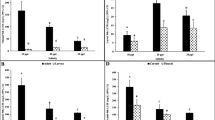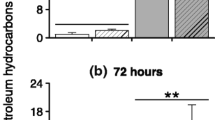Abstract
The acute toxicities of several oil dispersants to the larvae of haddock, herring, lemon sole, pilchard, plaice and sole were examined, the type and aromatic content of the solvent being the main factors influencing the toxicity. Newer (“second generation”) dispersants had much lower toxicities. Ageing of dispersant solutions led to a decrease in toxicity, which could be related to loss of aromatic compounds from solution. Temperature and salinity had only slight influence on toxicity. For all dispersants, differences of susceptibility between species were less than differences at different ages within a species. The larvae of all species showed a similar susceptibility when newly hatched, and susceptibility increased throughout the yolk-sac stage. The transition period from yolk reserves to an external food supply was most critical, for once larvae had established feeding, resistance increased until metamorphosis. The dispersants appeared to act largely as physical toxins causing, initially at least, a reversible narcosis. The implications of the results are discussed in relation to the use of dispersants at sea.
Similar content being viewed by others
Literature Cited
Blaxter, J.H.S.: The feeding of herring larvae and their ecology in relation to feeding. Calif. coop. ocean. Fish. investl Rep. 10, 79–88 (1965)
—: Rearing herring larvae to metamorphosis and beyond. J. mar. biol. Ass. U.K. 48, 17–28 (1968)
—: Experimental rearing of pilchard larvae, Sardina pilchardus. J. mar. biol. Ass. U.K. 49, 557–575 (1969)
— and G. Hempel: The influence of egg size on herring larvae (Clupea harengus L.). J. Cons. perm. int. Explor. Mer 28, 211–240 (1963)
Boney, A.D.: Experiments with some detergents and certain intertidal algae. Fld Stud. 2, (Suppl.), 55–72 (1968)
Calamari, D. and R. Marchetti: The toxicity of mixtures of metals and surfactants to rainbow trout (Salmo gairdneri Rich.). Wat. Res. 7, 1453–1464 (1973)
Connor, P.M.: Further investigations into the toxicity of oil and dispersants. Int. Coun. Explor. Sea Comm. Meet. 1972 (E: 14), 1–4 (1972). (Mimeo)
Corner, E.D.S., A.J. Southward and E.C. Southward: Toxicity of oil-spill removers (‘detergents’) to marine life: an assessment using the intertidal barnacle Elminius modestus. J. mar. biol. Ass. U.K. 48, 29–47 (1968)
Crapp, G.B.: Laboratory experiments with emulsifiers. In: Ecological effects of oil pollution on littoral communities, pp 129–149. Ed. by E.B. Cowell. Institute of Petroleum (U.K.) 1971a
—: The biological consequences of emulsifier cleansing. In: Ecological effects of oil pollution on littoral communities, pp 150–168. Ed. by E.B. Cowell. Institute of Petroleum (U.K.) 1971b
Crisp, D.J., A.O. Christie and A.F.A. Ghobashy: Narcotic and toxic action of organic compounds on barnacle larvae. Comp. Biochem. Physiol. 22, 629–649 (1967)
Eisler, R.: Some effects of a synthetic detergent on estuarine fishes. Trans. Am. Fish. Soc. 94, 26–31 (1965)
Gerade, H.W. and P. Skiba: Toxicologic studies on hydrocarbons: VI. A colorimetric method for the determination of kerosine in blood. Clin. Chem. 6, 327–331 (1960)
Goldacre, R.J.: Effect of detergents and oils on the cell membrane. Fld Stud. 2 (Suppl.), 131–137 (1968)
Howell, B.R.: Preliminary experiments on the rearing of larval lemon sole Microstomus kitt (Walbaum) on cultured foods. Aquaculture 1, 39–44 (1972)
Kühnhold, W.W.: Der Einfluß wasserlöslicher Bestandteile von Rohölen und Rohölfraktionen auf die Entwicklung von Heringsbrut. Ber. dt. wiss. Kommn Meeresforsch 20, 165–171 (1969)
Kühnhold, W.W.: The influence of crude oils on fish fry. In: Marine pollution and sea life, pp 315–318. Ed. by M. Ruivo. Fishing News (Books) Ltd. 1972
Lindén, O.: Effects of oil spill dispersants on the early development of Baltic herring. Annls zool. fenn. 11, 141–148 (1974)
Litchfield, J.T.: A method for rapid graphic solution of time-per cent effect curves. J. Pharmac. exp. Ther. 97, 399–408 (1949)
Maldura, C.: Recherches preliminaires sur l'action de l'alkyl-arylsulfonate sur la truite arc-en-ciel (Salmo irideus). Proc. tech. Pap. gen. Fish. Coun. Mediterr. 6, 203–206 (1961)
Manwell, C. and C.M.A. Baker: A study of detergents by molecular methods: starch gel electrophoresis of a variety of enzymes and other proteins. J. mar. biol. Ass. U.K. 47, 659–676 (1967)
Marchetti, R.: Critical review of the effects of synthetic detergents on aquatic life. Stud. Rev. gen. Fish. Coun. Mediterr. 26, 1–32 (1965)
Perkins, E.J.: The toxicity of oil emulsifiers to some inshore fauna. Fld Stud. 2 (Suppl.), 81–90 (1968a)
—: Some sub-lethal effects of BP 1002 upon marine gastropod molluscs. J. Devon Trust 19, 794–798 (1968b)
—: Some effects of detergents in the marine environment. Chemy Ind. 1970, 14–22 (1970)
Portmann, J.E. and P.M. Connor: The toxicity of several oil-spill removers to some species of fish and shellfish. Mar. Biol. 1, 322–329 (1968)
Prat, J. and A. Giraud: The pollution of water by detergents, 86 pp. Paris: Organisation for Economic Co-operation and Development 1964
Ryland, J.S.: Observations on the development of larvae of the plaice, Pleuronectes platessa L., in aquaria. J. Cons. perm. int. Explor. Mer 30, 177–195 (1966)
Shelbourne, J.E.: The artificial propagation of marine fish. Adv. mar. Biol. 2, 1–83 (1964)
Ryland, J.S.: Growth of plaice larvae in captivity. Int. Coun. Explor. Sea Comm. Meet. (F: 24) 1–4 (1969). (Mimeo)
Simpson, A.C.: The Torrey Canyon disaster and fisheries, Lab. Leaf. Fish. Lab. Burnham-on-Crouch (N.S.) 18, 1–43 (1968)
Smith, J.E. (Ed.): ‘Torrey Canyon’ pollution and marine life, 196 pp. Cambridge: University Press 1968
Sprague, J.B.: Measurement of pollutant toxicity to fish. I Bioassay methods for acute toxicity. Wat. Res. 3, 793–821 (1969)
Wilson, K.W.: Effects of oil dispersants on the embryos of marine fish. Mar. Biol. 36, 259–268 (1976)
Author information
Authors and Affiliations
Additional information
Communicated by J.H.S. Blaxter, Oban
Rights and permissions
About this article
Cite this article
Wilson, K.W. Acute toxicity of oil dispersants to marine fish larvae. Marine Biology 40, 65–74 (1977). https://doi.org/10.1007/BF00390629
Accepted:
Issue Date:
DOI: https://doi.org/10.1007/BF00390629




